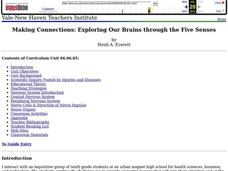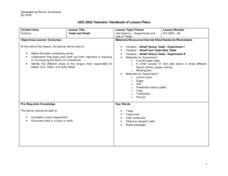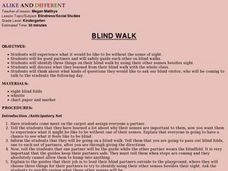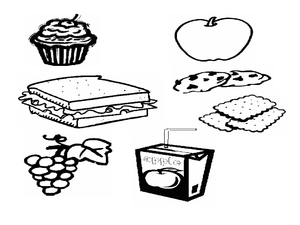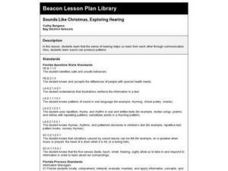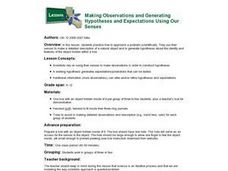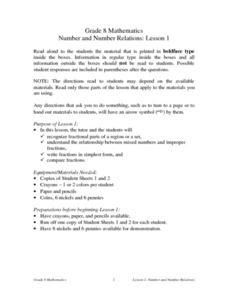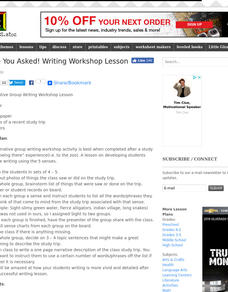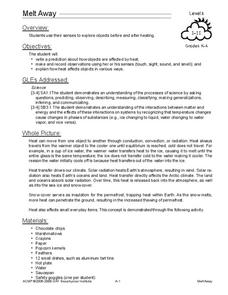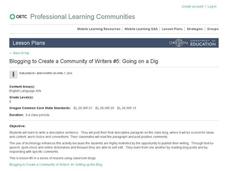Curated OER
Contaminated Drinking Water
Students predict, experiment, and draw conclusions about the safety of drinking water. In this ecology lesson, students participate in an experiment to determine if they can taste or see contamination in drinking water. Data is collected...
Curated OER
Making Connections: Exploring Our Brains through the Five Senses
Students identify structures of the brain, and neurons and analyze their functions. In this nervous system lesson plan students create drawings and models of anatomy.
Curated OER
Taste and Smell
Students experiment with sense of smell, and how it relates to sense of taste.
Curated OER
Blind Walk
Students experience what it would be like to live without the sense of sight, identify three things on a blind walk by using senses other than sight, and discuss what they learned from the experience with the whole class.
Serendip
How Do We Sense the Flavors of Food?
We taste with our taste buds, so why do flavors change when we have a stuffy nose? Scholars experiment with taste testing while holding their noses and then while smelling. They record their observations in pairs and come together to...
Curated OER
Mystery of the Senses-Taste
Students investigate the senses involved with taste. In an activity, students demonstrate the way that our senses of touch and smell combine with taste. Blindfolded, and with "plugged" noses, students taste foods. They complete a test...
Curated OER
Engineering and the Senses
Students explore nutrition. In this nutrition lesson, students discuss a person's sense of taste and how it is different for each person. Students discuss favorite foods and how they relate to nutrition. Students cut out pictures of...
Curated OER
Sounds Like Christmas, Exploring Hearing
Students see that the sense of hearing helps us learn from each other through communication. Also, students explain that sound can produce patterns. They engage in a wide variety of activities that focus on the sense of hearing.
University of Minnesota
Motor Learning and Memory
What do our brains have to do with reaction timing? Everything! In a hands-on learning activity, young scientists participate in four card activities that measure reaction timing. Each activity gets progressively more complex, and...
Curated OER
Making Observations and Generating Hypotheses
Students practice how to approach a problem scientifically. They use their senses to make a detailed description of a natural object and to generate hypotheses about the identity and features of the object hidden within a box.
Curated OER
Ears Here!
Learners participate in an interactive video to review the five senses. They perform hands-on activities to test their sense of hearing and play a hearing game from the Internet.
Curated OER
Number and Number Relations: Lesson 1
In a detailed format, this plan walks learners through an introduction to place value. They explore place value words and concepts and recognize patterns in the number system. Students identify a number when given a number word. They use...
Curated OER
Sense You Asked!
Fourth graders, in groups, brainstorm words that relate to the 5 senses after going on a field trip. The groups collect their words and create a piece of writing about the trip.
Curated OER
Mystery Box
Students predict what mystery objects are based on how they feel. In this sense of touch lesson plan, students reach inside a box and make a guess about the object inside. Once students record their predictions, the objects are revealed....
Curated OER
Number Sense
Students convert between decimals and fractions. For this algebra lesson, students show their knowledge of numbers by putting them on a number line. They apply the concept of algebra to solving word problems. Students will use a Ti...
Curated OER
What's in the Sock?
Second graders use their sense of touch to identify a variety of objects. In this sense of touch instructional activity, 2nd graders listen to a read aloud of Sandra Boynyon's, Fuzzy Fuzzy, Fuzzy. They talk about different textures and...
Curated OER
Use Your Nose
Students explore how their senses work. In this senses lesson, students use the sense of smell to observe various spices. Students discuss their findings.
Curated OER
Melt Away
Students explore objects before and after heating using their senses. In this matter and energy lesson, students experiment with a variety of objects and use their senses (except taste) to make predictions and record observations...
Curated OER
Fun With Adhesives
Students observe, measure, and record the properties in making objects stick together using science tools. In this science lesson, students explore with their senses while mixing flour and water. Additionally, students share their...
Curated OER
Earth Day Number Sense
Elementary schoolers count and order objects using numbers 1-300. They bring recyclable items from home. Students group the items, skip count by 2's, 3's, and 5's, and arrange the items on a number line. Recyclable plastic bags are put...
Kenan Fellows
Evaluating Sensors and the Impacts of Physiological Stress: Designing a Wearable Device for Rescue Workers
A long-term project has scholars consider ways in which sensors help monitor physiological stress levels of rescue workers. They design and create a portable device for this purpose. Techies to the rescue!
Curated OER
100 Or Bust!
Elementary schoolers use their understanding of place value to develop a strategy for a number game. For this lesson, pupils use place value to play "100 or Bust" and figure out a good winning strategy. These kinds of math games are...
Curated OER
Blogging To Create A Community of Writers # 5 of 7
Here is lesson 5 from a 7 lesson unit on using blogging to create a community of writers. The aim of this lesson is to get students writing about what Archaeologists do and how they use material data to study the past. They compose a...
Curated OER
Oobleck Versus Gloop
Second graders explain that we use our senses to make observations and that the observations often describe properties of an object or substance. They make oobleck, then perform a series of tests on it.

